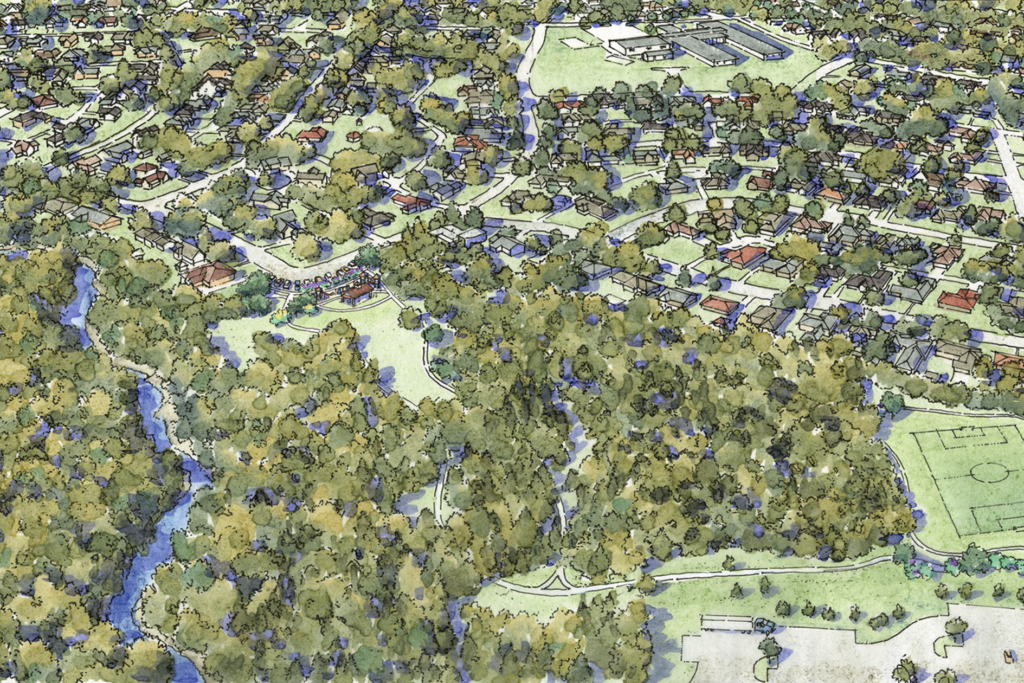Since the City Council passed a racial equity plan in August,City Manager T.C. Broadnax has tried to find money to pay for targeted investments in parts of the city where more Black and Latino residents live—parts of town that have not received the same level of investment compared to more affluent, more predominantly White neighborhoods.
Some of those investments will be paid for with an extra $20 million from higher-than-anticipated sales tax revenue, which the City Council approved to set aside for those racial equity initiatives. Broadnax developed a list of more than a dozen ideas, from giving a few hundred families $250 a month to upgrading crosswalks and streets in Pleasant Grove.
Mayor Eric Johnson wants the city manager to use the excess sales tax revenue to pay for the Five Mile Creek Urban Greenbelt, which would create new parks and a nature preserve linked by more than a dozen miles of new trails through Oak Cliff.
A little jockeying was perhaps inevitable. Mayor Johnson on Monday sent a memo to Broadnax, highlighting his position as “the sole citywide elected representative” and his desire to allocate the money for “long-lasting infrastructure and community improvement projects rather than toward pilot programs with short-term limited impact at best.”
That’s clearly targeted at the city manager’s pilot program that seeks to join about 30 other cities in giving some of the poorest residents in Dallas a monthly stipend of $250. The pilot project would include 325 families. But there are other one-time cash infusions in the plan; Broadnax has proposed using $1 million to seed an anti-displacement homebuyer assistance fund, targeted at families who earn 60 percent to 120 percent of the area median income. (Those numbers are established annually by the U.S. Department of Housing and Urban Development. To qualify, a family of four would earn between $51,720 and $103,440.)
They could receive up to $50,000 per household. Elsewhere, Broadnax proposes rent subsidies and housing relocation assistance, which would serve 165 families in “equity priority areas.”
Johnson makes a point that he’s a son of such parts of Dallas, “historically underserved and overlooked neighborhoods in the city” like West Dallas and Oak Cliff. “I believe that there are better uses for these funds that will help Dallas now and in the years to come,” he writes.
The Five Mile Creek project has been in the works for years,designed by the Dallas office of the Austin-based landscape architecture firm TBG Partners and ushered along by the Trust for Public Land, the nonprofit that has helped preserve greenspace in Oak Cliff, Highland Hills, and near Eagle Mountain Lake, among other areas.
Five Mile Creek extends through the hills and valleys of southwest Dallas, 70 square miles that would connect Chalk Hill Trail, Kiest Park, Glendale Park, South Oak Cliff High School, Paul Quinn College, and the new extension through the Trinity Forest that will soon be part of the 50-mile LOOP Trail.
“Dallas is in a trail-building renaissance, with new trails opening throughout the city,” the mayor writes. “But none of these trails connect to Oak Cliff. The Five Mile Creek Greenbelt will fill that gap and provide the first-ever way for these residents to access the city’s 160+ other miles of trails.”
The Dallas Park and Recreation Board approved a master plan for the Five Mile Creek Urban Greenbelt in February 2019. The greenbelt would be a series of new parks, like the Judge Charles R. Rose Community Park, which broke ground in June; South Oak Cliff Renaissance Park, which opened last November; and the Alice Branch Creek Park, for which the city acquired the necessary land to build it on in 2021.
Adjacent to Alice Branch Creek will be the Woody Branch greenspace, 82 acres that the Trust for Public Land plans to turn into a nature preserve.
A series of trails would connect these amenities, offering southern Dallas much-needed accessible greenspace.
“This is a project that improves the environment and the health, quality of life, and mobility of residents of the historically underserved and overlooked communities who we are seeking to serve through the Racial Equity Plan,” Johnson’s memo reads.
Johnson notes that there is a “shovel-ready” stretch of trail near Kiest Park that would cost somewhere around $7.1 million. From there, the mayor says, the remaining design and engineering work would cost another $8.3 million.
Suddenly, that extra $20 million doesn’t look like quite as much.
The debate over how the money will be used also shows how difficult these decisions can be: the city is trying to correct generations of disinvestment, helping people find places to live while improving infrastructure and amenities. Tristan Hallman, the mayor’s chief of policy and communications, says he expects that Council will need to approve the programs and expenditures before they’re funded.
The idea of giving residents money is already controversial; the Dallas Morning News editorial board published a piece in opposition over the weekend, and Hallman says the mayor “does not support a cash giveaway program.”
The city’s racial equity plan establishes what it terms “Big, Audacious Goals,” many of which aren’t difficult to identify. SMU professor Barbara Minsker and her civil engineering students mapped what they called “infrastructure deserts,” identifying 62 that lacked basics like sidewalks, internet access, and parks and trails.
That’s a lot of work—expensive work. It’s clear from these recent discussions that not everyone will agree on what to prioritize.
“There are limited dollars and a lot of possibilities, so [the mayor is] looking for the most impactful projects first that fit the objectives of investing in historically underserved and overlooked communities,” Hallman said in a text.
Get the D Brief Newsletter
Author




